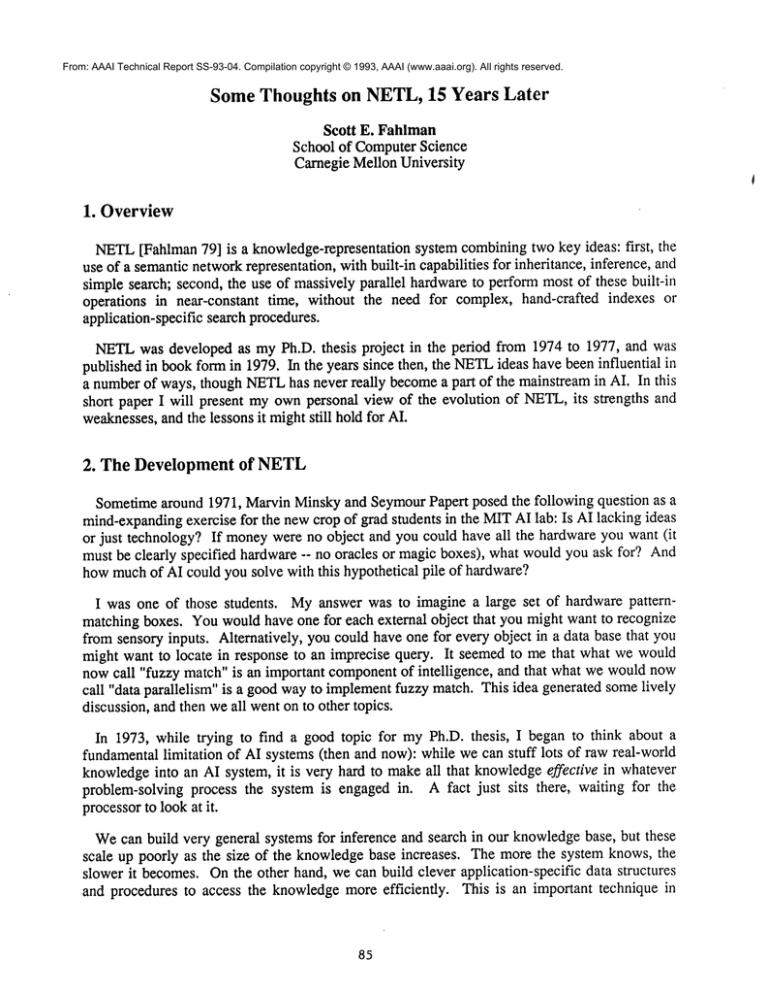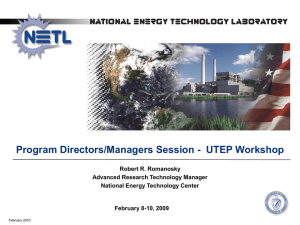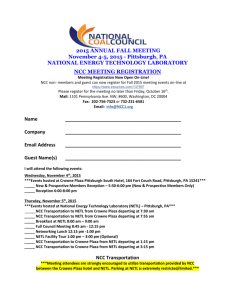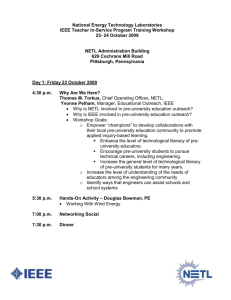
From: AAAI Technical Report SS-93-04. Compilation copyright © 1993, AAAI (www.aaai.org). All rights reserved.
Some Thoughts on NETL, 15 Years Later
Scott E. Fahlman
School of ComputerScience
Carnegie Mellon University
1. Overview
NETL[Fahlman79] is a knowledge-representation system combining two key ideas: first, the
use of a semanticnetworkrepresentation, with built-in capabilities for inheritance, inference, and
simple search; second, the use of massively parallel hardware to perform most of these built-in
operations in near-constant time, without the need for complex, hand-crafted indexes or
application-specific search procedures.
NETLwas developed as my Ph.D. thesis project in the period from 1974 to 1977, and was
published in book form in 1979. In the years since then, the NETL
ideas have been influential in
a numberof ways, though NETLhas never really becomea part of the mainstreamin AI. In this
short paper I will present my ownpersonal view of the evolution of NETL,its strengths and
weaknesses,and the lessons it mightstill hold for AI.
2. The Development of NETL
Sometimearound 1971, Marvin Minskyand SeymourPapert posed the following question as a
mind-expandingexercise for the newcrop of grad students in the MITAI lab: Is AI lacking ideas
or just technology? If moneywere no object and you could have all the hardware you want (it
must be clearly specified hardware -- no oracles or magic boxes), what would you ask for? And
howmuchof AI could you solve with this hypothetical pile of hardware?
I was one of those students. Myanswer was to imagine a large set of hardware patternmatching boxes. Youwould have one for each external object that you might want to recognize
from sensory inputs. Alternatively, you could have one for every object in a data base that you
might want to locate in response to an imprecise query. It seemed to me that what we would
nowcall "fuzzy match" is an important componentof intelligence, and that what we wouldnow
call "data parallelism" is a good wayto implementfuzzy match. This idea generated somelively
discussion, and then weall went on to other topics.
In 1973, while trying to find a good topic for myPh.D. thesis, I began to think about a
fundamentallimitation of AI systems (then and now): while we can stuff lots of raw real-world
knowledgeinto an AI system, it is very hard to makeall that knowledgeeffective in whatever
problem-solving process the system is engaged in. A fact just sits there, waiting for the
processorto look at it.
Wecan build very general systems for inference and search in our knowledgebase, but these
scale up poorly as the size of the knowledgebase increases. The more the system knows, the
slower it becomes.Onthe other hand, we can build clever application-specific data structures
and procedures to access the knowledgemore efficiently. This is an important technique in
85
mainstreamAI, but the resulting systems are narrow, brittle, and very difficult to build. It
seemed to me that there must be a way to build a very general inference system that would
operate quickly and scale up well to huge sizes. Wehumansseemto have such a facility in our
brain, and our broad, flexible intelligence dependson this.
NETLwas born whenI began to apply myold ideas for massive parallelism to this difficult
problem, mixing in some ideas about semantic networks and marker passing from M. Ross
Quillian [Quillian 68]. NETLis a semantic network memory,with nodes representing "things"
and classes and links representing relationships and statements. In NETL,each node and link is
represented by a simple processing element, capable of storing a few distinct single-bit markers
and passing them to their neighbors in the network. The physical network is wired up to match
the topology of the semantic network. The marker bits flow through the net in parallel, under
overall control of a central processingunit.
The parallel hardwareschemeused in NETLfell into place very quickly, but it took methree
years to understand its properties and to develop a knowledge-representationlanguage to go with
it.
A NETL-styleparallel memoryoffers several advantages for AI:
¯ Certain kinds of inference and search, such as property inheritance and set
intersection, occur in constant time.
¯ Because simple inference is fast, the knowledgecan be put into the system in raw
form, without any application-specific programming.Each item can be used in a
variety of ways, some of which were not anticipated whenthe item was added.
¯ NETLcan makeuse of implicit knowledgealmost as easily as explicit knowledge.
If the knowledgebase knows that all elephants are gray and (by some chain of
reasoning) that Clyde is an elephant, there is no need to store the assertion that
Clydeis gray.
¯ In recognition, all the possible matchescan be evaluated at once.
¯ Because one marker can gate the flow of another, it is possible to implement
exceptions and context-dependent statements in NETL.
¯ The abilities and weaknesses of NETLare in manyways (but not all) more like
those of a humanthan like those of an AI programon a serial computer.
Because of these features, NETLgenerated a good deal of interest when the book first
appeared. At that time, there was little interest in parallel processing amongAI researchers. The
early flowering of "neural network" approaches in the 1960’s had stalled (temporarily, as it
turned out), and parallel machineswere still cosily and hard to program. NETLwas one of the
elements that led AI people to take a newlook at parallel approaches, or at least not to reject
themout of hand. This helped to pave the wayfor the resurgence of neural nets in the 1980’s.
3. What ever became of NETL?
NETLhad someserious disadvantages as well. The most obvious was that, in the late 1970’s,
NETLwas just a theoretical exercise using imaginary parallel hardware. The system was simple
86
enough that one could predict pretty reliably howa large NETLsystem of, say, a million
processing elements would behave, but it wouldhave been extremely expensive to build such a
system. Evenin those days, it wasnot unthinkable to create 106 simple processors, each capable
of storing 16 markerbits, but the reconfigurable networkof inter-unit connections, all operating
in parallel, wasanother matter.
After receiving my doctorate and movingto Carnegie Mellon, I began exploring a numberof
switching network designs, and I finally developed a plausible design for a million-element
NETLmachine[Fahlman80]. This machinewas never built for two reasons: first, by this time,
my own interest was turning away from NETLand toward more fuzzy models of knowledge
representation and inference (see below); second, DannyHillis and his colleagues at MIT,
inspired in part by the data-parallel style of NETL,had begun a large project to produce what
they called a "connection machine"[Hillis 85], the precursor to the line of machinesdeveloped
by Thinking MachinesCorporation (and their imitators). The Connection Machinearchitecture
incorporated manyfeatures that went beyondthe specific needs of NETL,but it was clear that if
this machinesucceeded it would be a good engine for studying NETL-styleparallel AI. Andso
it is, thoughthe existing ConnectionMachinesare primarily used for tasks other than "thinking".
A second limitation of NETLwas in the nature of marker-passing parallelism itself (see
[Fahlman82]). It took mea couple of years during the thesis research to really understand this
issue. Basically, a NETLmachine that passes single-bit markers can perform many useful
functions in parallel -- transitive closure, set intersection, and so on -- but it cannotdo arbitrary
theorem proving or pattern-matching in parallel. A NETLmachine can mark all dogs with
marker M1, all dog-owners with marker M2, and all dogs hated by some dog-owner with marker
M3. But NETLcannot, in parallel, mark every dog whois hated by his own owner. This would
require the "I ownyou" and "I hate you" markers to carry some sort of signature field, plus
machinery in each DOGnode to see if these signatures match. Such matching requires much
more expensive hardware than the simple marker-passing of NETL,and it introduces the
possibility of contention and delay if too manyof these complexmessagesare sent to the same
recipient. (Colliding markerbits, on the other hand, can simply be OR’edtogether into a single
message.)
A numberof researchers, including EugeneCharniak and Jim Hendler, have explored what can
be done with these morecomplexmassively parallel message-passingsystems, but this approach
has never held muchinterest for me. I personally believe that the additional operations provided
by message-passingparallelism are not worth the added cost and that these operations are not
really neededfor human-likeintelligence.
A third limitation of NETLis that the knowledgerepresentation I developed for it was
informal and not rooted in any existing logic. This was a deliberate choice: I have always been
more interested in what a piece of knowledge does than what it means. In NETLI was more
concerned with links, marker flows, and queries than with how to express the equivalent
knowledgein some formal system of non-monotoniclogic. However,this informal approach did
permit some paradoxical situations to arise whenexceptions (and thus non-monotonicinference)
were present in the network [Fahlman 81]. Mystudent, Dave Touretzky, explored the question
of howto formalize non-monotonicinheritance in his Ph.D. thesis [Touretzky 86], and this line
of inquiry lives on in subsequent workby Touretzky, Thomason,Horty, and others.
87
A final limitation of NETL,in myview, is that it is an implementationof standard, symbolic,
non-fuzzy AI in parallel hardware. In NETL,either Clyde is an elephant or he is not; NETLhas
no good way of dealing with degrees of uncertainty, or with elephants that are very poor
specimens of their class. While this "crisp", symbolic orientation is an attraction for some
researchers, my owninterest has turned increasingly to the question of howwe represent and
reason about the fuzzy, imprecise, uncertain knowledgethat plays so large a role in the real
world. (I share Lotfi Zadeh’s belief that these issues are very important, though I have no
particular attachmentto his particular brand of fuzzy logic.)
While the field of knowledgerepresentation becameincreasingly formal and precise in the
1980’s, I began to experiment with Thistle, a fuzzy version of NETLthat passed around
continuous values rather than single-bit markers [Fahlman83]. I quickly realized that building
Thistle networks by hand was muchmoredifficult than building crisp, clean NETLnetworks. It
becameclear to me that automatic learning from examples was going to be extremely important
in these less-symbolic systems, but I didn’t knowhow such learning could be done. The
emergenceof improvedlearning algorithms for artificial neural networks finally provided an
answer, and I have been workingin that area ever since. I think that NETL,in its original form,
still has somegoodideas worth pursuing, but I have put this on the back burner for now.
4. NETLToday and Tomorrow
Thoughit has been influential in a numberof ways, as described above, NETLhas never really
becomea part of the AI mainstream. There are several reasons for this: First, NETL
was perhaps
a decade ahead of its time in terms of hardware. Only recently, as massively parallel machines
have becomemore widely available and affordable, have mainstreamAI researchers been able to
experiment with such systems. Second, the whole field of knowledgerepresentation has gone
through a period in whicheverything must be formalized, even if this meansthrowing out useful
functionality (e.g. the ability to create exceptions to general rules). Third, I and someof the
other researchers whomight have built large systems on top of NETLhave turned instead to the
exciting newfield of neural networks.
Despite all this, it seems puzzling to methat people whostill want to workwith symbolic AI
knowledge-representation systems have not paid more attention to the ideas in NETL.Hundreds
of people work in knowledgerepresentation, developing formalisms and inference rules, but
very few of themhave faced the question of howto scale their systems up to the size required for
human-likecommon
sense. If they think hard about this issue of scaling, I think that they will
inevitably be led to somethinglike NETLor someother massively parallel scheme.
For whatever reason, scaling issues seemnot to be on the agenda. As Roger Schank once said
to me, "NETLis not really AI. It’s just a speedup hack -- an implementation technology. The
real AI question is what knowledgeshould go into the system and howthat knowledgecan be
used to solve problems." I disagree with this viewpoint, but perhaps it explains the limited role
that NETLhas played in the field.
Lenat’s CYCproject seems to be based on a view similar to Schank’s: put in the right
knowledge and don’t worry too much about how long it will take you to find a piece of
knowledgewhenyou need it. In myview, the scaling issues are fundamentaland should be dealt
88
4
with before we start stuffing in the knowledge. Perhaps the pendulumwill swing back in the
near future. Perhaps researchers will look again at what we can do if given "all the hardware we
want", nowthat hardwareis so cheap.
Acknowledgment
Preparation of this paper was supported by the National Science Foundation, Grant
IRI-9214873.The views expressed here are those of the author and do not necessarily reflect the
views of the National Science Foundation.
References
Fahlman, S. E. (1979) NETL:A System for Representing and Using Real-World Knowledge,
MIT Press, Cambridge MA.
Fahlman, S. E. (1980) "Design Sketch for a Million-Element NETLMachine", Proceedings
AAAI-80Conference, Morgan-Kaufmann,Los Altos CA.
Fahlman, S. E., D. S. Touretzky, and W. van Roggen (1981) "Cancellation in a Parallel
Semantic Network"Proceedings of IJCAI-81, Vancouver, British Columbia.
Fahlman, S. E. (1982) "Three Flavors of Parallelism", Proceedings of the Fourth National
Conference, CanadianSociety for Studies of Intelligence, Saskatoon, Saskatchewan.
Fahlman,S. E., G. E. Hinton, and T. J. Sejnowski(1983) "MassivelyParallel Architectures for
AI: NETL,Thistle, and Boltzmann Machines" in Proceedings of the AAAI-83Conference,
Morgan-Kaufmann,Los Altos CA.
Hillis, W. D. (1985) The Connection Machine, MITPress.
Quillian, M. R. (1968), "Semantic Memory" in Semantic Information
M. L. Minsky(ed.), MITPress.
Touretzky, D. S. (1986), The Mathematics of Inheritance
Kaufmannpublishers.
89
Processing,
Systems, Pitman & Morgan





